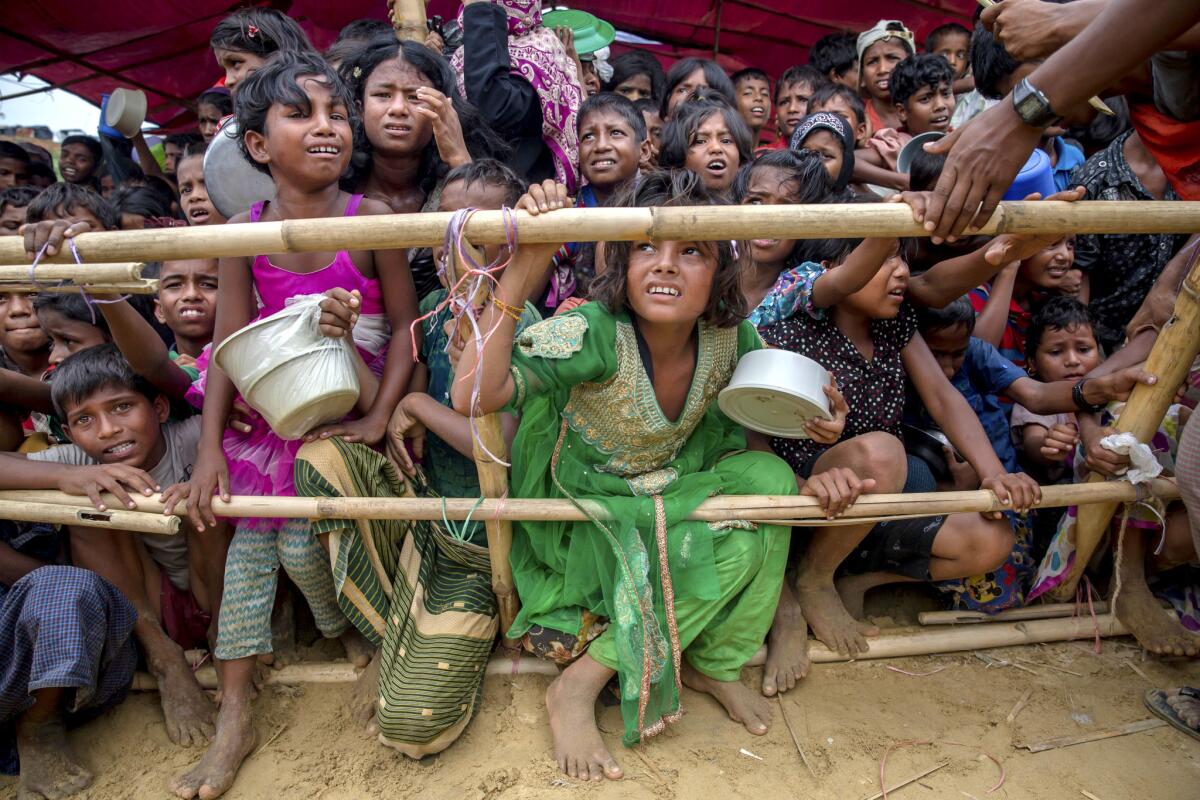What will Asia do about the humanitarian crisis unfolding on its doorstep?
- Share via
The Assn. of Southeast Asian Nations, a 10-nation regional bloc encompassing more than 600 million people, will mark its 50th anniversary at a summit beginning Sunday in the Philippines. Attendees are to include
With a rare moment in the global spotlight, ASEAN faces a crucial question: Will it address the humanitarian catastrophe involving Rohingya Muslims that is unfolding on its doorstep?
But ASEAN, which maintains a policy of noninterference in members’ domestic affairs, has remained mostly silent. The summit website has posted condolences to victims of bombings in Iraq and hurricanes in the Caribbean — but nothing on what international aid agencies describe as the world’s most urgent humanitarian crisis.
What is the Rohingya crisis?
In late August, the army in Myanmar, formerly known as Burma, responded to a series of militant attacks by unleashing a scorched-earth campaign across northern Rakhine state in the country’s west, home to more than 1 million Rohingya Muslims.
Humanitarian groups estimate that more than 600,000 Rohingya have fled the onslaught and settled in overcrowded refugee camps across the border in Bangladesh.
Because journalists and independent agencies have been, in effect, barred from northern Rakhine, it has not been possible to assess the extent of the damage or how many people were killed.
Refugees who reached Bangladesh — including children who were separated from their parents — have told aid workers that Myanmar soldiers burned their homes, sexually assaulted and executed villagers and shot others as they fled.

How serious is the humanitarian situation?
After a visit to refugee camps in Bangladesh this month, Simon Henshaw, the acting assistant U.S. secretary of State for refugee affairs, described the conditions as “shocking.”
Despite an outpouring of international aid, humanitarian agencies have struggled to meet the needs of the swelling population of new arrivals, including many who arrive gravely ill from the journey.
In one camp, Kutupalong, the United Nations Children’s Fund reported this month that 26,000 refugees face acute shortages of food and water and high rates of diarrhea and respiratory infections. An assessment found that 7.5% of children in the camp faced life-threatening severe acute malnutrition.
“Those with severe malnutrition are now at risk of dying from an entirely preventable and treatable cause,” said UNICEF’s Bangladesh representative, Edouard Beigbeder.
What has been Myanmar’s response?
Myanmar’s government does not recognize the Rohingya as one of 135 official ethnic groups and regards them as Bangladeshis who migrated to the country illegally. Many Rohingya families dispute this, saying their roots in western Myanmar date back generations.
Suu Kyi visited the state last week for the first time since the exodus began and has said Myanmar would begin allowing refugees to return home — although experts believe that because Myanmar doesn’t consider the Rohingya citizens, they could be barred from reentering the country.
At the summit, the aloof Suu Kyi could be pushed to answer questions.
“She will be forced to meet people and talk about this, which is a healthy thing,” said Khin Zaw Win, director of the Tampadipa Institute, an independent think tank in Myanmar. “In a democracy that’s the kind of thing that must happen.”
How have regional countries reacted?
The crisis has split Southeast Asia largely along religious lines. When ASEAN issued a tepid statement in September — expressing support for Myanmar’s government and even omitting the term Rohingya — predominantly Muslim Malaysia distanced itself from the document.
Malaysian Prime Minister
Large anti-Myanmar protests have erupted in Indonesia, the world’s largest Muslim-majority country. Indonesia, where ASEAN is headquartered, has offered low-profile humanitarian assistance, setting up a hospital in Rakhine that treats members of all ethnic groups.
Thailand, which in past years has turned away Rohingya refugees attempting to flee Rakhine by boat, has supported Myanmar, a close ally. Singapore has hewed to the principle of noninterference.
What could the ASEAN meeting accomplish?
The U.N. Security Council issued a statement this week calling on Myanmar to end the use of excessive force and allow full access to U.N. agencies investigating abuses. Human rights groups argue that regional leaders should raise pressure on Myanmar to allow a U.N. fact-finding mission.
The ASEAN meeting, along with an Asia-Pacific economic summit preceding it in Vietnam, affords a chance for strong action on a problem that “is among the worst human rights catastrophes in Asia in years,” said Brad Adams, Asia director for
“World leaders shouldn’t return home from these summits without agreeing to targeted sanctions to pressure Burma to end its abuses and allow in independent observers and aid groups,” Adams said.
Could Trump play a role? He has urged “strong and swift” action to end violence against the Rohingya, and his administration has withdrawn aid to Myanmar’s military. Trump could use the crisis to needle the Obama administration, which staunchly supported Suu Kyi, but so far he has skirted human rights issues on his Asia trip.
Khin Zaw Win said ASEAN could not be taken seriously as a global body if the Rohingya were not on its agenda.
“ASEAN is trying to assert itself and take center stage in this part of the world,” he said. “If this issue were to be swept under the carpet, it would really be very shabby.”
Twitter: @SBengali
Sign up for Essential California
The most important California stories and recommendations in your inbox every morning.
You may occasionally receive promotional content from the Los Angeles Times.








